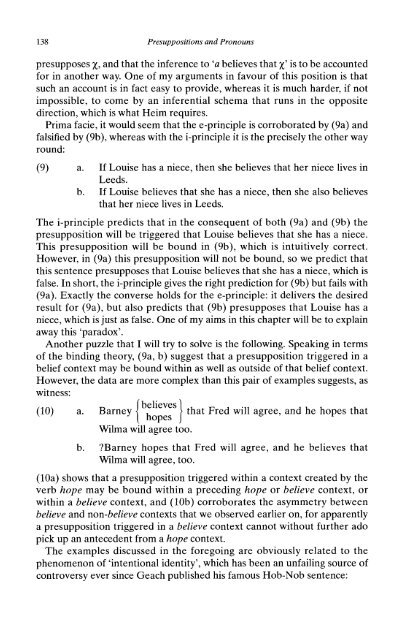Presuppositions and Pronouns - Nijmegen Centre for Semantics
Presuppositions and Pronouns - Nijmegen Centre for Semantics
Presuppositions and Pronouns - Nijmegen Centre for Semantics
You also want an ePaper? Increase the reach of your titles
YUMPU automatically turns print PDFs into web optimized ePapers that Google loves.
138 <strong>Presuppositions</strong> <strong>and</strong> <strong>Pronouns</strong><br />
presupposes %, X, <strong>and</strong> that the inference to 'a '0 believes that %' X' is to be accounted<br />
<strong>for</strong> in another way. One of my arguments in favour of this position is that<br />
such an account is in fact easy to provide, whereas it is much harder, if not<br />
impossible, to come by an inferential schema that runs in the opposite<br />
direction, which is what Heim requires.<br />
Prima facie, it would seem that the e-principle is corroborated by (9a) <strong>and</strong><br />
falsified by (9b), whereas with the i-principle it is the precisely the other way<br />
round:<br />
(9) a. If Louise has a niece, then she believes that her niece lives in<br />
Leeds.<br />
b. If Louise believes that she has a niece, then she also believes<br />
that her niece lives in Leeds.<br />
The i-principle predicts that in the consequent of both (9a) <strong>and</strong> (9b) the<br />
presupposition will be triggered that Louise believes that she has a niece.<br />
This presupposition will be bound in (9b), which is intuitively correct.<br />
However, in (9a) this presupposition will not be bound, so we predict that<br />
this sentence presupposes that Louise believes that she has a niece, which is<br />
false. In short, the i-principle gives the right prediction <strong>for</strong> (9b) but fails with<br />
(9a). Exactly the converse holds <strong>for</strong> the e-principle: it delivers the desired<br />
result <strong>for</strong> (9a), but also predicts that (9b) presupposes that Louise has a<br />
niece, which is just as false. One of my aims in this chapter will be to explain<br />
away this 'paradox'.<br />
Another puzzle that I will try to solve is the following. Speaking in terms<br />
of the binding theory, (9a, b) suggest that a presupposition triggered in a<br />
belief context may be bound within as well as outside of that belief context.<br />
However, the data are more complex than this pair of examples suggests, as<br />
witness:<br />
(10) a. Barney {\ believes} , h \ that Fred will WIll . agree, <strong>and</strong> he hopes that<br />
opes<br />
Wilma will agree too.<br />
b. Barney hopes that Fred will agree, <strong>and</strong> he believes that<br />
Wilma will agree, too.<br />
(lOa) shows that a presupposition triggered within a context created by the<br />
verb hope may be bound within a preceding hope or believe context, or<br />
within a believe context, <strong>and</strong> (lOb) corroborates the asymmetry between<br />
believe <strong>and</strong> non-believe contexts that we observed earlier on, <strong>for</strong> apparently<br />
a presupposition triggered in a believe context cannot without further ado<br />
pick up an antecedent from a hope context.<br />
The examples discussed in the <strong>for</strong>egoing are obviously related to the<br />
phenomenon of 'intentional identity', which has been an unfailing source of<br />
controversy ever since Geach published his famous Hob-Nob sentence:














